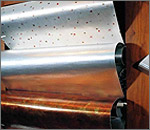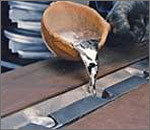Aluminium is a silvery white and ductile member of the boron group of chemical elements. It has the symbol Al; its atomic number is 13. It is not soluble in water under norm

al circumstances. Aluminium is the most abundant metal in the Earth's crust, and the third most abundant element therein, after oxygen and silicon. It makes up about 8% by weight of the Earth's solid surface. Aluminium is too reactive chemically to occur in nature as a free metal. Instead, it is found combined in over 270 different minerals. The chief source of aluminium is bauxite ore.
Aluminium is remarkable for its ability to resist corrosion due to the phenomenon of passivation and for the metal's low density. Structural components made from aluminium and its alloys are vital to the aerospace industry and very important in other areas of transportation and building. Its reactive nature makes it useful as a catalyst or additive in chemical mixtures, including being used in ammonium nitrate explosives to enhance blast power.
History
The ancient Greeks and Romans used alum as an astringent and as a mordant in dyeing. In 1761 de Morveau proposed the name alumine for the base in alum, and Lavoisier, in 1787, thought this to be the oxide of a still undiscovered metal.
Wohler is generally credited with having isolated the metal in 1827, although an impure form was prepared by Oersted two years earlier. In 1807, Davy proposed the name aluminum for the metal, undiscovered at that time, and later agreed to change it to aluminum. Shortly thereafter, the name aluminum was adopted to conform with the "ium" ending of most elements, and this spelling is now in use elsewhere in the world.
Aluminium was also the accepted spelling in the U.S. until 1925, at which time the American Chemical Society officially decided to use the name aluminum thereafter in their publications.
Sources:
The method of obtaining aluminum metal by the electrolysis of alumina dissolved in cryolite was discovered in 1886 by Hall in the U.S. and at about the same time by Heroult in France. Cryolite, a natural ore found in Greenland, is no longer widely used in commercial production, but has been replaced by an artificial mixture of sodium, aluminum, and calcium fluorides.
Aluminum can now be produced from clay, but the process is not economically feasible at present. Aluminum is the most abundant metal to be found in the earth's crust (8.1%), but is never found free in nature. In addition to the minerals mentioned above, it is also found in granite and in many other common minerals.
Properties:
Pure aluminum, a silvery-white metal, possesses many desirable characteristics. It is light, it is nonmagnetic and nonsparking, stands second among metals in the scale of malleability, and sixth in ductility.
Uses:
It is extensively used for kitchen utensils, outside building decoration, and in thousands of industrial applications where a strong, light, easily constructed material is needed.
Although its electrical conductivity is only about 60% that of copper, it is used in electrical transmission lines because of its light weight. Pure aluminum is soft and lacks strength, but alloyed with small amounts of copper, magnesium, silicon, manganese, or other elements impart a variety of useful properties.

These alloys are of vital importance in the construction of modern aircraft and rockets. Aluminum, evaporated in a vacuum, forms a highly reflective coating for both visible light andradiant heat. These coatings soon form a thin layer of the protective oxide and do not deteriorate as do silver coatings. They are used to coat telescope mirrors and to make decorative paper, packages,and toys.
Compounds:
The compounds of greatest importance are aluminum oxide, the sulfate, and the soluble sulfate with potassium (alum). The oxide, alumina, occurs naturally as ruby (Al2O3), sapphire, corundum, and emery, and is used in glassmaking and refractories. Synthetic ruby and sapphire are used in lasers for producing coherent light.


